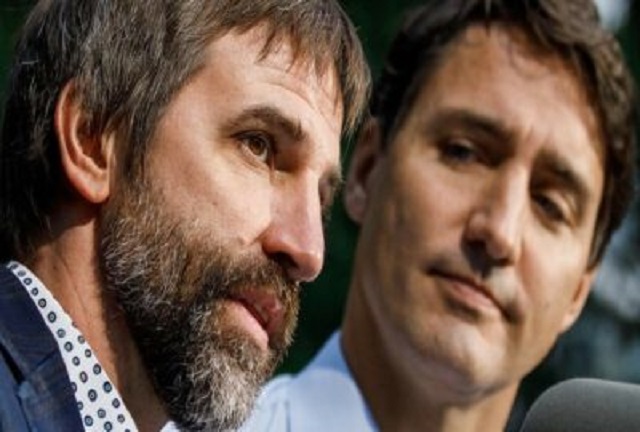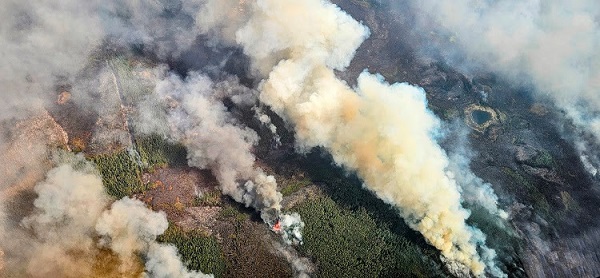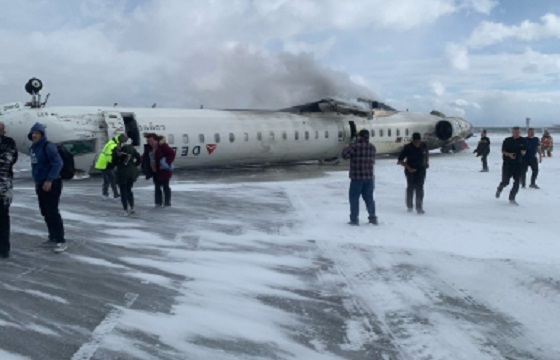Disaster
Albertans petition to dump Federal Environment Minister Steven Guilbeault over Jasper fire failures

From Free Alberta Strategy
The Truth Behind Jasper’s Wildfire
For years, forestry experts have been warning of a looming wildfire disaster in Jasper National Park as a result of trees killed by beetle-infestation acting as tinder.
As it turns out, the rapid spread of the fire that led to the destruction of homes and businesses may have been preventable, and federal Environment and Climate Change Minister Steven Guilbeault is blaming climate change instead of taking responsibility for years of federal mismanagement.
The July wildfire has triggered nearly $900 million in insurance claims, making it one of the costliest disasters in Canadian history.
Unfortunately for Guilbeault, this wasn’t just a natural disaster – it was a preventable one.
Guilbeault’s position contradicts numerous warnings about the potential for a major fire in Jasper.
As early as 2017, both the town’s mayor and the local MP raised concerns:
“The dead forest is not so much the tourism concern – it’s a burned up town that can no longer service visitors,” Ireland said. “Apart from the impact it will have on the people who live here, their livelihood, their health and safety and their property.”
“We can’t be complacent. We need to take action to try and do everything we can to safeguard the community.”
A year later, researchers Ken Hodges and Emile Begin specifically warned that a massive fire was inevitable, with Begin describing it as “a matter of when, not if.”
Hodges reflected in July that he was “frustrated” by the destruction and that “we tried to warn them that it was coming.”
“We told them constantly.”
If Guilbeault’s defense wasn’t flimsy enough, new revelations from a parliamentary committee investigating the causes of the disaster make it clear that Ottawa mishandled the response.
Even when the fire broke out, federal officials turned down critical help.
Testimony from firefighter Kristopher Liivam revealed that a convoy of 20 fire trucks was stopped at the entry to the park by Parks Canada officials three days after the fire started.
The federal government went so far as to refuse to authorize joint command with the Alberta government, who had expanded its firefighting budget by more than 50% to a record $155.4 million for the 2024 wildfire season.
Alberta Public Safety Minister Mike Ellis told the committee that he was “very concerned” about the fact that firefighters were turned away during a natural disaster, going on to say that if Alberta had joint command “our position would be that we wouldn’t be turning away anybody.”
“That’s a question… you should probably ask the minister or the national park,” Ellis responded when committee member Dane Lloyd inquired about the Province’s lack of involvement in the unified command structure.
Ellis was, of course, referring to Guilbeault, whose role as Environment and Climate Change Minister also includes overseeing the operations of the national park – catastrophic fire prevention being a major part of that portfolio.
As Postmedia columnist Don Braid puts it, “The refusal to grant joint command was both bizarre and churlish.”
Predictably, rather than owning up to these mistakes, Guilbeault has blamed climate change for the disaster.
Politically, as Braid (again) aptly points out, “A big ugly fire in Alberta is a great boost for [Guilbeault’s] climate agenda.”
Sure enough, when Guilbeault testified, he defended his department’s response, stating “There was no stopping this fire, and no forest was going to escape its path.”
To the big brains in Ottawa, climate change is the culprit.
Albertans aren’t buying it.
Dead trees from years of pine-beetle infestation were left standing, creating dangerous conditions that could have been addressed.
Despite this, Guilbeault is insisting that Jasper was one of Canada’s most “fire-prepared” communities before the 32,000 hectare inferno was sparked in late July.
Shockingly, he even tried to pin the blame on the Conservative Party of Canada, which hasn’t been in power since 2015.
“I find it incredibly ironic that your party… would be asking these questions when you oppose both measures to fight climate change and measures to adapt to climate change.”
Guilbeault and his team ignored repeated warnings about the risks of catastrophic fire, yet they are now using climate change as a convenient excuse to cover up their mismanagement.
If Jasper was, in fact, one of the most “fire-prepared” communities in the country that means the risk of catastrophic fire is greater than originally thought across Canada.
Guilbeault has made it clear that his policies and failures to act are more about political gains than protecting people’s lives and homes.
The fact that this government would use the devastation in Jasper to double down on their expensive and unpopular climate agenda is further proof that he is not fit to lead.
Jasper’s tragedy wasn’t inevitable.
It was a result of federal mismanagement, negligence, and refusal to take action when it was most needed.
Steven Guilbeault has shown time and again that he’s unfit to serve as Environment Minister.
The voices calling for Guilbeault’s removal are growing louder because his inability to lead is endangering more than just our environment – it’s endangering our communities.
If you agree, please sign the petition today to demand that Steven Guilbeault be fired:
In politics, accountability is essential.
It’s time to hold Steven Guilbeault accountable for his failure to protect Jasper and ensure that something like this never happens again.
Together, we can demand real solutions to prevent future disasters.
Thank you for your continued support!
Regards,
The Free Alberta Strategy Team
The Free Alberta Strategy is a series of initiatives our Provincial Government can implement today, without needing any permission from Ottawa, to make Alberta a sovereign jurisdiction within Canada.
The Strategy has two key objectives:
- Establishing complete Provincial Legislative Sovereignty within Canada
- Ending Equalization and Net Federal Transfers out of Alberta
Alberta
New teams will boost Alberta wildfire preparedness

Alberta’s government is investing almost $7 million to create six new Wildland Urban Interface (WUI) teams to protect communities at risk from wildfires.
In response to increased wildfire activity in recent years, Alberta’s government is taking action to better safeguard communities and strengthen the way emergencies are responded to. This includes record investments in equipment and personnel, as well as targeted strategies to enhance local firefighting capacity, readiness and resilience.
Alberta’s government is responding proactively to wildfire threats by funding six local fire departments through the Wildland Urban Interface Program to boost wildfire preparedness and response capabilities. This initiative quadruples the number of existing Wildland Urban Interface teams, ensuring a stronger, more coordinated effort to protect communities from potential wildfire emergencies.
“Alberta’s government continues to make critical investments to strengthen the way emergencies are handled. We are effectively quadrupling the number of Wildland Urban Interface teams in Alberta to ensure the safety of Albertans’ businesses, neighbourhoods and critical infrastructure during wildfires.”
“Firefighting teams like this can truly make the difference when it comes to protecting Alberta’s communities. Having more Wildland Urban Interface teams improves our capabilities and adaptability when our wildland firefighting teams are fighting fires across Alberta.”
The Wildland Urban Interface Program targets zones where developments such as homes, farms or industrial sites border or mix with natural vegetation at risk from wildfire. Fires that occur in these transitional areas between forests, grasslands and populated communities are often challenging and demand the expertise of both wildland and structural firefighters. Wildland Urban Interface teams consist of firefighters who have the specialized training and equipment needed to respond to wildfires that enter a community or where developed areas meet wildland areas.
This program is a partnership between the provincial government and local authority fire services and includes funding from Natural Resources Canada. The province is responsible for coordination and funding, while local fire departments contribute personnel, firefighting equipment and resources. The expansion of this program will enhance the overall deployment of specialized resources across the province and improve municipal fire service capacity through additional training and technical support.
“The announcement of almost $7 million in funding to quadruple the number of Wildland Urban Interface teams will strengthen Alberta’s wildfire preparedness and significantly improve safety for Strathmore residents. As the local MLA, I am proud to support the growth of these versatile teams, which are deployed across the province to support municipalities like ours and reinforce our local firefighting capabilities.”
“Strathmore’s firefighters have repeatedly shown their skill, commitment and leadership during emergency deployments. Participation in the WUI Program allows us to strengthen those capabilities, enhance regional partnerships, and help build a sustainable response model for our community and province.”
Each new Wildland Urban Interface Team will receive $1.09 million over two to three years for personnel costs, administrative support, equipment, maintenance and travel costs to help develop and expand the program’s training and operational capacity.
The local authorities receiving funding are:
- Town of Strathmore
- Town of Hinton
- Town of Slave Lake
- Lac La Biche County
- Kee Tas Kee Now Tribal Council
- Kananaskis Improvement District
There are two existing teams based out of Clearwater County and the Town of High Level.
Quick facts
- Funding for the Town of Hinton, Town of Slave Lake, Lac La Biche County and Kee Tas Kee Now Tribal Council is shared equally between Natural Resources Canada and Alberta Forestry and Parks.
- Funding for the teams based in the Town of Strathmore and Kananaskis Improvement District will be provided by the Alberta Emergency Management Agency.
- Each team will receive a total of $1.09 million for a combined total of close to $7 million.
Related information
Disaster
Delta flight crashes and flips upside-down at Toronto airport as 3 are left critically injured

Quick Hit:
A Delta Air Lines plane crash-landed and flipped upside-down at Toronto Pearson International Airport on Monday, leaving three passengers— including a child— critically injured. The incident occurred just before 3 p.m. after the aircraft took off from Minneapolis earlier in the day. Images from the scene show the plane severely damaged, with emergency crews rushing to assist passengers.
BREAKING- Toronto had a Delta flight flipped upside down. I got these photos from a friend on the plane. He’s okay. Minnesota to Toronto. pic.twitter.com/DeSoYAlsVo
— Kellie Meyer (@KellieMeyerNews) February 17, 2025
Key Details:
- The flight, identified as Delta Flight 4819, departed from Minneapolis at 11:47 a.m. before crash-landing in Toronto.
- At least eight people were reported injured, with three in critical condition, including a child and a man in his 60s.
- The aircraft, a Bombardier CRJ-900LR, was flipped upside-down on the runway, with one wing crumpled and the tail section partially sheared off.
Diving Deeper:
Emergency responders rushed to Toronto Pearson International Airport on Monday afternoon after Delta Flight 4819 suffered a crash landing, flipping upside-down on the snowy runway. Images from the scene depict a harrowing sight— the overturned aircraft smoldering, with dazed passengers evacuating.
According to CP24 News, eight people sustained injuries in the crash, three of whom were transported to separate hospitals in critical condition, including a pediatric patient. The Peel Regional Police confirmed that while most passengers made it out unharmed, authorities remained on-site to assess the full extent of the injuries and damage.
Passenger John Nelson captured the immediate aftermath on video, posting to Facebook: “We’re in Toronto. We just landed. Our plane crashed, it’s upside-down. Fire department is on site. Most people appear to be OK. We’re all getting off.” The footage shows emergency personnel navigating the snowy conditions to reach the aircraft and assist those on board.
Toronto Pearson officials confirmed on X (formerly Twitter) that all passengers and crew were accounted for, while the Association of Flight Attendants union stated that no fatalities had been reported. However, airport operations were briefly suspended in the wake of the incident, with arrivals and departures temporarily halted.
The crash comes after a weekend winter storm dumped nearly nine inches of snow on Toronto, prompting airport crews to work overnight to clear runways. Investigators will now seek to determine whether weather conditions or mechanical failure played a role in the crash. This marks the most serious commercial aviation incident since the January 29 collision at Ronald Reagan National Airport involving an Army Black Hawk helicopter and an American Airlines flight.
-

 Health1 day ago
Health1 day agoLast day and last chance to win this dream home! Support the 2025 Red Deer Hospital Lottery before midnight!
-

 conflict1 day ago
conflict1 day ago“Evacuate”: Netanyahu Warns Tehran as Israel Expands Strikes on Iran’s Military Command
-

 Energy1 day ago
Energy1 day agoKananaskis G7 meeting the right setting for U.S. and Canada to reassert energy ties
-

 Alberta2 days ago
Alberta2 days agoAlberta’s grand bargain with Canada includes a new pipeline to Prince Rupert
-

 Business24 hours ago
Business24 hours agoCarney’s Honeymoon Phase Enters a ‘Make-or-Break’ Week
-

 Aristotle Foundation1 day ago
Aristotle Foundation1 day agoThe Canadian Medical Association’s inexplicable stance on pediatric gender medicine
-

 Business2 days ago
Business2 days agoCarney’s European pivot could quietly reshape Canada’s sovereignty
-

 Energy1 day ago
Energy1 day agoCould the G7 Summit in Alberta be a historic moment for Canadian energy?






